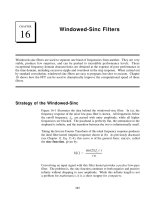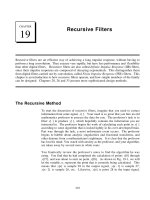Moving Average Filters
Bạn đang xem bản rút gọn của tài liệu. Xem và tải ngay bản đầy đủ của tài liệu tại đây (161.97 KB, 8 trang )
277
CHAPTER
15
EQUATION 15-1
Equation of the moving average filter. In
this equation, is the input signal, isx[ ] y[ ]
the output signal, and M is the number of
points used in the moving average. This
equation only uses points on one side of the
output sample being calculated.
y[i] '
1
M
j
M &1
j '0
x [i %j ]
y [80] '
x [80] % x [81] % x [82] % x [83] % x [84]
5
Moving Average Filters
The moving average is the most common filter in DSP, mainly because it is the easiest digital
filter to understand and use. In spite of its simplicity, the moving average filter is optimal for
a common task: reducing random noise while retaining a sharp step response. This makes it the
premier filter for time domain encoded signals. However, the moving average is the worst filter
for frequency domain encoded signals, with little ability to separate one band of frequencies from
another. Relatives of the moving average filter include the Gaussian, Blackman, and multiple-
pass moving average. These have slightly better performance in the frequency domain, at the
expense of increased computation time.
Implementation by Convolution
As the name implies, the moving average filter operates by averaging a number
of points from the input signal to produce each point in the output signal. In
equation form, this is written:
Where is the input signal, is the output signal, and M is the numberx[ ] y[ ]
of points in the average. For example, in a 5 point moving average filter, point
80 in the output signal is given by:
The Scientist and Engineer's Guide to Digital Signal Processing278
y[80] '
x[78] % x[79] % x[80] % x[81] % x[82]
5
100 'MOVING AVERAGE FILTER
110 'This program filters 5000 samples with a 101 point moving
120 'average filter, resulting in 4900 samples of filtered data.
130 '
140 DIM X[4999] 'X[ ] holds the input signal
150 DIM Y[4999] 'Y[ ] holds the output signal
160 '
170 GOSUB XXXX 'Mythical subroutine to load X[ ]
180 '
190 FOR I% = 50 TO 4949 'Loop for each point in the output signal
200 Y[I%] = 0 'Zero, so it can be used as an accumulator
210 FOR J% = -50 TO 50 'Calculate the summation
220 Y[I%] = Y[I%] + X(I%+J%]
230 NEXT J%
240 Y[I%] = Y[I%]/101 'Complete the average by dividing
250 NEXT I%
260 '
270 END
TABLE 15-1
As an alternative, the group of points from the input signal can be chosen
symmetrically around the output point:
This corresponds to changing the summation in Eq. 15-1 from: ,j ' 0 to M&1
to: . For instance, in a 10 point moving averagej ' &(M&1)/2 to (M&1)/2
filter, the index, j, can run from 0 to 11 (one side averaging) or -5 to 5
(symmetrical averaging). Symmetrical averaging requires that M be an odd
number. Programming is slightly easier with the points on only one side;
however, this produces a relative shift between the input and output signals.
You should recognize that the moving average filter is a convolution using a
very simple filter kernel. For example, a 5 point filter has the filter kernel:
. That is, the moving average filter is aþ 0, 0, 1/5, 1/5, 1/5, 1/5, 1/5, 0, 0 þ
convolution of the input signal with a rectangular pulse having an area of one.
Table 15-1 shows a program to implement the moving average filter.
Noise Reduction vs. Step Response
Many scientists and engineers feel guilty about using the moving average filter.
Because it is so very simple, the moving average filter is often the first thing
tried when faced with a problem. Even if the problem is completely solved,
there is still the feeling that something more should be done. This situation is
truly ironic. Not only is the moving average filter very good for many
applications, it is optimal for a common problem, reducing random white noise
while keeping the sharpest step response.
Chapter 15- Moving Average Filters 279
Sample number
0 100 200 300 400 500
-1
0
1
2
a. Original signal
Sample number
0 100 200 300 400 500
-1
0
1
2
b. 11 point moving average
FIGURE 15-1
Example of a moving average filter. In (a), a
rectangular pulse is buried in random noise. In
(b) and (c), this signal is filtered with 11 and 51
point moving average filters, respectively. As
the number of points in the filter increases, the
noise becomes lower; however, the edges
becoming less sharp. The moving average filter
is the optimal solution for this problem,
providing the lowest noise possible for a given
edge sharpness.
Sample number
0 100 200 300 400 500
-1
0
1
2
c. 51 point moving average
Amplitude Amplitude
Amplitude
Figure 15-1 shows an example of how this works. The signal in (a) is a pulse
buried in random noise. In (b) and (c), the smoothing action of the moving
average filter decreases the amplitude of the random noise (good), but also
reduces the sharpness of the edges (bad). Of all the possible linear filters that
could be used, the moving average produces the lowest noise for a given edge
sharpness. The amount of noise reduction is equal to the square-root of the
number of points in the average. For example, a 100 point moving average
filter reduces the noise by a factor of 10.
To understand why the moving average if the best solution, imagine we want
to design a filter with a fixed edge sharpness. For example, let's assume we fix
the edge sharpness by specifying that there are eleven points in the rise of the
step response. This requires that the filter kernel have eleven points. The
optimization question is: how do we choose the eleven values in the filter
kernel to minimize the noise on the output signal? Since the noise we are
trying to reduce is random, none of the input points is special; each is just as
noisy as its neighbor. Therefore, it is useless to give preferential treatment to
any one of the input points by assigning it a larger coefficient in the filter
kernel. The lowest noise is obtained when all the input samples are treated
equally, i.e., the moving average filter. (Later in this chapter we show that
other filters are essentially as good. The point is, no filter is better than the
simple moving average).
The Scientist and Engineer's Guide to Digital Signal Processing280
EQUATION 15-2
Frequency response of an M point moving
average filter. The frequency, f, runs between
0 and 0.5. For , use: f ' 0 H[ f ] ' 1
H [f ] '
sin(Bf M )
M sin(Bf )
Frequency
0 0.1 0.2 0.3 0.4 0.5
0.0
0.2
0.4
0.6
0.8
1.0
1.2
3 point
11 point
31 point
FIGURE 15-2
Frequency response of the moving average
filter. The moving average is a very poor
low-pass filter, due to its slow roll-off and
poor stopband attenuation. These curves are
generated by Eq. 15-2.
Amplitude
Frequency Response
Figure 15-2 shows the frequency response of the moving average filter. It is
mathematically described by the Fourier transform of the rectangular pulse, as
discussed in Chapter 11:
The roll-off is very slow and the stopband attenuation is ghastly. Clearly, the
moving average filter cannot separate one band of frequencies from another.
Remember, good performance in the time domain results in poor performance
in the frequency domain, and vice versa. In short, the moving average is an
exceptionally good smoothing filter (the action in the time domain), but an
exceptionally bad low-pass filter (the action in the frequency domain).
Relatives of the Moving Average Filter
In a perfect world, filter designers would only have to deal with time
domain or frequency domain encoded information, but never a mixture of
the two in the same signal. Unfortunately, there are some applications
where both domains are simultaneously important. For instance, television
signals fall into this nasty category. Video information is encoded in the
time domain, that is, the shape of the waveform corresponds to the patterns
of brightness in the image. However, during transmission the video signal
is treated according to its frequency composition, such as its total
bandwidth, how the carrier waves for sound & color are added, elimination
& restoration of the DC component, etc. As another example, electro-
magnetic interference is best understood in the frequency domain, even if
Chapter 15- Moving Average Filters 281
Sample number
0 6 12 18 24
0.0
0.1
0.2
2 pass
4 pass
1 pass
a. Filter kernel
Sample number
0 6 12 18 24
0.0
0.2
0.4
0.6
0.8
1.0
1.2
1 pass
4 pass
2 pass
b. Step response
Frequency
0 0.1 0.2 0.3 0.4 0.5
-120
-100
-80
-60
-40
-20
0
20
40
1 pass
2 pass
4 pass
d. Frequency response (dB)
FIGURE 15-3
Characteristics of multiple-pass moving average filters. Figure (a) shows the filter kernels resulting from
passing a seven point moving average filter over the data once, twice and four times. Figure (b) shows the
corresponding step responses, while (c) and (d) show the corresponding frequency responses.
FFT
Integrate 20 Log( )
AmplitudeAmplitude
Frequency
0 0.1 0.2 0.3 0.4 0.5
0.00
0.25
0.50
0.75
1.00
1.25
1 pass
2 pass
4 pass
c. Frequency response
Amplitude (dB)
Amplitude
the signal's information is encoded in the time domain. For instance, the
temperature monitor in a scientific experiment might be contaminated with 60
hertz from the power lines, 30 kHz from a switching power supply, or 1320
kHz from a local AM radio station. Relatives of the moving average filter
have better frequency domain performance, and can be useful in these mixed
domain applications.
Multiple-pass moving average filters involve passing the input signal
through a moving average filter two or more times. Figure 15-3a shows the
overall filter kernel resulting from one, two and four passes. Two passes are
equivalent to using a triangular filter kernel (a rectangular filter kernel
convolved with itself). After four or more passes, the equivalent filter kernel
looks like a Gaussian (recall the Central Limit Theorem). As shown in (b),
multiple passes produce an "s" shaped step response, as compared to the
straight line of the single pass. The frequency responses in (c) and (d) are
given by Eq. 15-2 multiplied by itself for each pass. That is, each time domain
convolution results in a multiplication of the frequency spectra.









